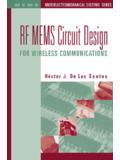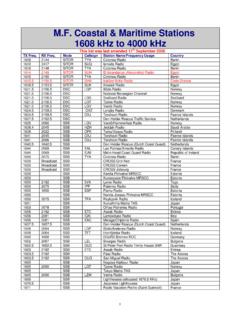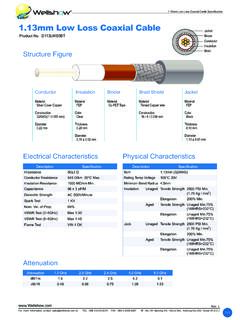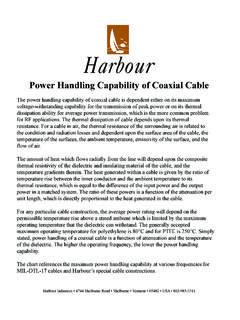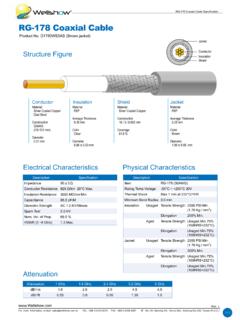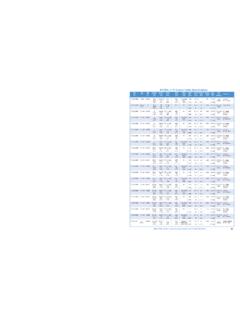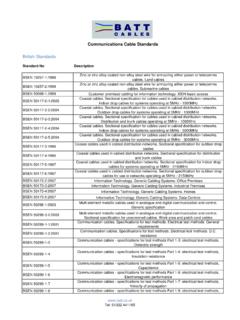Transcription of Coaxial Traps for Multiband Antennas, the True …
1 Nov/Dec 2004 19 Watzmannstr, 24AD-85586 POINGG ermanyCoaxial Traps forMultiband Antennas, the true Equivalent CircuitBy Karl-Otto M ller, DG1 MFTA new perspective on the analysis anddesign of this popular antenna antenna DesignParallel-resonant circuits (calledtraps) are widely used to isolate partsof Multiband antennas to make theantenna resonant on different fre-quencies (see Fig 1). For more than 20years these circuits have been imple-mented as coils wound from ,2,3 As shown in Fig 2, the in-ner conductor of the coil end is con-nected to the outer conductor at thebeginning. Therefore the current isgoing around the core two times thenumber of turns. The Coaxial cablecapacitance represents the capacitorof this parallel-resonant circuit.
2 For aneasy design of Coaxial Traps , VE6 YPoffers a program in the order to design Multiband anten-nas with programs such as EZNEC,5traps must be modeled as loads, de-fined by their equivalent circuit asshown in Fig 3. The easiest way todetermine the values of this circuit isto measure C, L and Rs. C may alsobe calculated from the coaxialcable length and the capacitance perunit length (reasonable estimate ifL < 1/10 ), but L has to be measuredby an appropriate inductance find out the series resistance Rs, the3-dB bandwidth of the trap must bemeasured as described in Fig SurpriseInsertion of the measured values ofC and L into Thomson s formulaCLfres = 21gives exactly half the frequency valuewhich was used in the Coaxial trapprogram of VE6YP to get the numberof turns of the example: The VE6YP calculationof a Coaxial cable trap for MHz us-ing RG58 with a core diameter of 35 mmyields 10 turns.
3 The resonance checkusing a network analyzer results MHz, which is close. EZNEC asksfor C, L and Rs, and we have to deter-mine these three values before we canstart an EZNEC that the resonant fre-quency is measured correctly, eitherthe value of L or C is only a quarter of1 Notes appear on page Nov/Dec 2004the measured and calculated value orboth are half the value. Only one ofthe following formulas is valid, butwhich?CLfres =421 or421 CLfres = or2221 CLfres = For a decision, the impedance ver-sus frequency of the resonant circuitis calculated for all three cases, andcompared with the measured valuesas shown in Fig can be seen clearly that the paral-lel combination L and C/4 is somebody may argue that it makesno difference which combination is usedfor the antenna design as long as theresonance frequency is the same.
4 Butthere is a significant difference:The impedance of the three paral-lel-resonant circuits differs by the fac-tor two or four respectively. The im-pedance of the correct combination L,C /4 is four times higher than the im-pedance of the non-correct parallelcombination of L/4 and C, which isgiven as a result of the VE6YP calcu-lation. Thus, the inductive load of thecorrect combination, L and C/4, has alengthening effect on the antenna be-low the first resonance (half the reso-nant frequency). As a result, theEZNEC antenna design, based on thecorrect equivalent circuit, results in aphysically shorter antenna and there-fore comes closer to ExplanationThree steps are used to show, whythe parallel combination of L and C/4is 1: Symbolical reduction of thenumber of turns to one, see Fig 2: The winding is cut at theopposite side and connected cross-over as in Fig 7.
5 The inputs are con-nected in 3: As can be seen from Fig 8,now the two capacitances, C/2 are con-nected in series, resulting in an effec-tive capacitance of 2 Typical Coaxial cable trap (QST, Dec 1984)Fig 1 Two-banddipole antennaFig 4 Measurement of the 3-dBbandwidth for calculation of RsFig 3 Equivalent circuit of a trapInfluence of the cable lengthLooking again at Fig 5, we find asignificant difference between mea-sured and calculated value, based onL in parallel with C, around 60 is suggested that this is caused bythe cable length. Fig 9 shows theequivalent circuit of our symbolic one-turn-coil for frequencies much higherthan the resonant frequency. Fig 10shows the voltage distribution at thesefrequencies.
6 At the input port, half thevoltage is across each of the coaxialcables. However, at the cross-over con-nection, both voltages are in phase andhave the same amplitude. Thereforethere is no current here as illustratedin Fig 10. Consequently, the cross-overconnection can be opened withoutchanging the behaviour at high fre-quencies, see Fig 11. For lower fre-quencies, up to approximately fourtimes the resonant frequency, the coilinductance can be simulated by a con- Nov/Dec 2004 21 Fig 6 For an easy explanation, number ofturns is reduced to 5 Impedance comparisonFig 7 The winding is cut at the oppositeside and connected cross-over . Thefunction of the coil remains 8 Distribution of capacitance andinductance of the coilFig 9 For higher frequencies theelectrical length le of the Coaxial cable 10 At the cross-over connection bothvoltages are in phase and have the 11 The cross-over connection can beopened without changing the behaviourfor high 12 The complete equivalent circuit ofa Coaxial cable trap with electrical cablelength le and coil inductance L with losses,represented by Rs22 Nov/Dec 2004centrated inductance L in parallelwith the input port.
7 In series with thisinductance we can insert the resis-tance representing the losses of thetrap, as measured by the method ofFig4. Now, Fig 12 shows the completeequivalent circuit of a Coaxial cabletrap. The measured impedance over awide frequency range (1 to 500 MHz)is given in Fig 13, showing minimawhere the total cable length le = 1/2 n (for odd n only) and maxima, where le= n (for arbitrary n).ConclusionIt has been shown that the coaxialcable trap (electrical length le of thecable) behaves as a parallel resonantcircuit, where = (1/n) le (arbitrary n)and forresfCL= 421 and as a series resonance circuit at allfrequencies where = (2/n) le (for oddn only).ConsequencesThe correct higher impedance of thecoaxial Traps , compared to the now-in-use impedance values according to theVE6YP software has two conse-quences.
8 The antenna length is more realistic(i. e. shorter) than predicted by thedesign software. The trap losses are significantly dif-ferent than predicted and should are illustrated in Fig would like to thank Hartwig,DH2 MIC, for helpful discussions andthe Rohde & Schwarz company,Munich, for providing me with valu-able test Johns, W3 JIP, Coaxial Cable AntennaTraps , QST, May 1981, pp 15 Sommer, N4UU, Optimizing CoaxialCable Traps , QST, Dec 1984, pp 37 ARRL antenna Book, 1988, Chapter 7,pp Field, VE6YP, Coaxial Trap Design, (Free-ware, ), is available from Roy Lewallen,W7EL, at M ller, DG1 MFT, Ersatzschaltbild f rFig 13 Impedance minima and maxima of the Coaxial cable trap from 1 MHz to 500 MHz.
9 Vertical log scale from 1 to 100 k Koaxiale Sperrkreise , Funkamateur 53(2004) Jan, pp 60-61 (in German).7K. M ller, DG1 MFT, Koaxiale Traps f rMultiband-Antennen, Das korrekteErsatzschaltbild , paper, presented at theDARC Radio Amateur Meeting in Munich,Mar 13/14, 2004 (in German), 14 Errors, caused by the use of the wrong ( L // C, upper picture, printed in red)equivalent circuit. The antenna below (green) is calculated on basis of the correctequivalent circuit (L // C). The differences in trap losses and voltages are notnegligible! Example is a dipole antenna for 40/80 m, applied power is 100 W, wires arelossless, 10 m above ground, Traps made from RG58 C/U, Q = M ller, DG1 MFT, was a de-velopment engineer at Rohde &Schwarz in Munich until his retire-ment.
10 For more than 40 years he wasresponsible for all EMI test instrumen-tation with a specialization in test re-ceivers.!!

